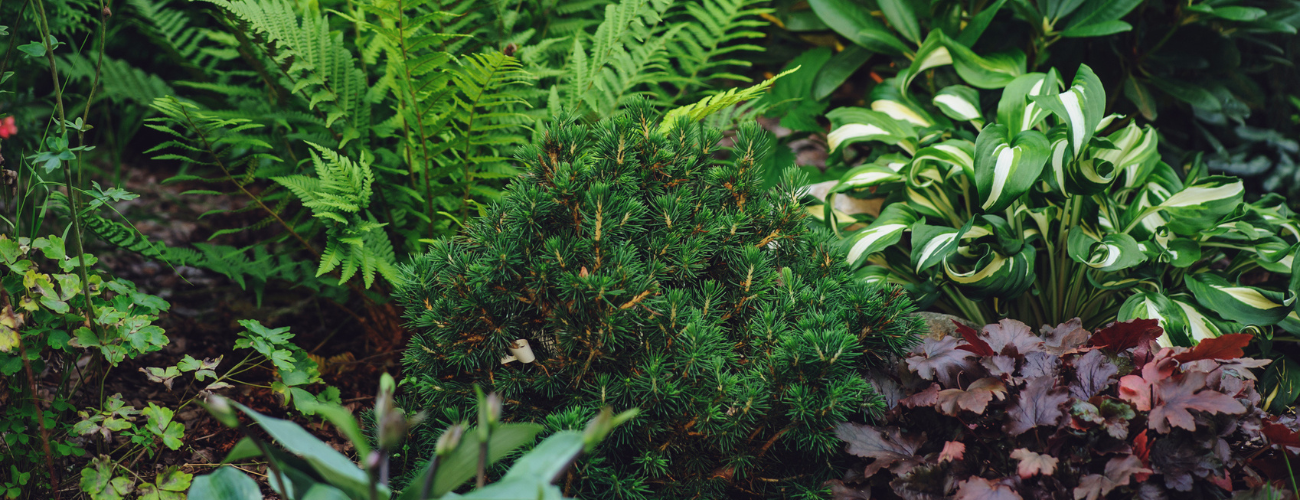Every garden has some form of shade whether it is cast by trees, hedges, buildings or fences. A shady space tucked in a corner is a useful spot to put utilities like the dustbins, tool shed or a compost heap. It is also a great place for a wildlife enticing log pile, perfect for hibernating frogs and toads. A shady part of your garden can provide a cool oasis of calm in hot weather and, as our climate changes, we will be needing more shady places to retreat to. There are many wonderful plants that can be used to green up and soften a shady spot. This article focusses on perennials for shade.
What kind of shade do you have?
Dappled shade
Dappled shade is created by sun shining through the leaves and branches of a tree throughout the day. Plants in dappled shade all day, may receive less than 3 hours of direct sunlight in summer.
Dappled shade is where many woodland plants like to grow. They make the most of the weak winter sun and lengthening days to emerge and flower before the canopy fills in. Many of these plants die back to the ground during the heat of summer, ready to reappear the following winter. Others retain their leafy foliage until autumn.
The following plants will enjoy dappled shade:
- Hellebores
- Pulmonaria
- Brunnera
- Epimedium
- Primroses
- Snowdrops
- Bluebells
- Winter aconites
- Cyclamen
- Wood anemones
- Heuchera
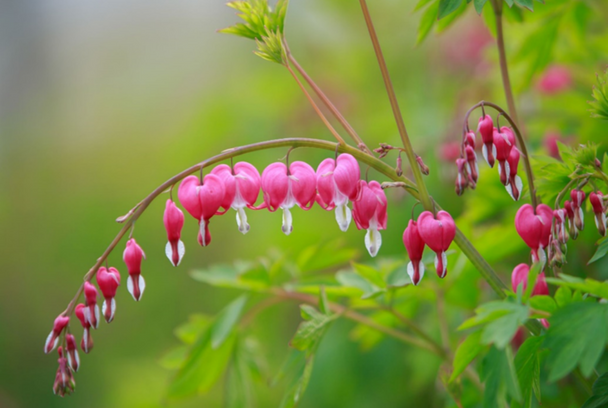
Dicentra spectabilis
Also known as Bleeding Heart, Dicentra is popular for its unique heart-shaped pink and white flowers with a central tear-drop. It blooms in early to mid-spring with the flowers hanging gracefully from long, arching stems. Pollinators such as bees and butterflies enjoy visiting for its nectar and pollen. Dicentra likes partial to full shade and moist, well-drained soil. It can grow up to 90 cm tall and wide, making it a great addition to woodland gardens or shady borders.
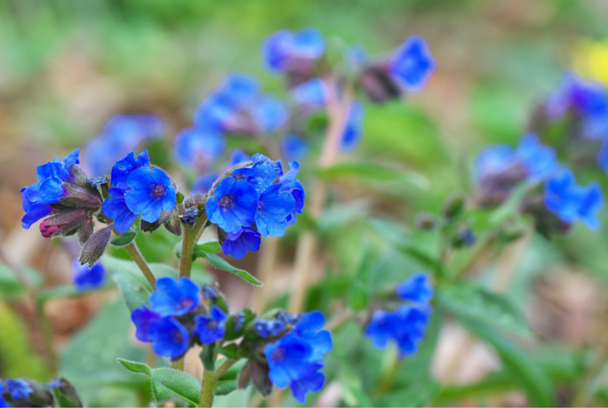
Pulmonaria
Commonly known as lungworts, Pulmonaria flower in spring. They have hairy leaves and produce clusters of flowers in shades of pink, blue, and purple. They are easy to grow and prefer a location with partial or full shade and moist, well-drained soil. Pulmonaria are wonderful in woodland gardens or as ground cover under trees and shrubs.
Partial shade
Partial shade refers to areas that receive between 3 and 6 hours of direct sun per day in midsummer. It is created by being in the shadow of a structure as the sun moves through the day. East facing walls, for example, receive sun in the morning but none in the afternoon. Plants for partial shade like to avoid the midday sun in midsummer, so are best suited to an east or west facing garden.
Plants suitable for partial shade include:
- Digitalis (foxgloves)
- Myosotis (forget-me-not)
- Japanese anemones
- Liriope
- Astilbe
- Geranium phaeum
- Campanula
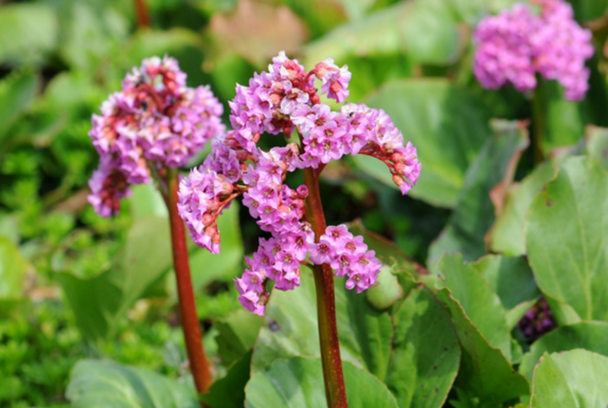
Bergenias
These are perennial plants commonly grown in gardens for their attractive evergreen foliage and colourful flowers. Their common name is “elephant’s ears” due to the shape of their large, glossy leaves. Bergenias typically grow in clumps and produce stalks of bell-shaped flowers in shades of pink, red, or white. They flower during the spring and early summer and often repeat flower in early autumn. Bergenia prefer moist, well-draining soil and partial shade, but can also tolerate full sun and dry conditions.

Hakonechloa
This is one of my favourites, a deciduous grass which looks wonderful in a jungle or Japanese inspired garden. Also known as Japanese forest grass, Hakonechloa is prized for its lush, cascading foliage. The grass has thin, arching leaves that are typically green, yellow or variegated. Hakonechloa prefers partial to full shade and moist, well-drained soil. It is a slow-growing plant that can take several years to reach maturity. Once established, it requires little maintenance and can provide a beautiful accent to shady areas.
Full shade
Full shade is what you will get against a north facing wall or under an evergreen tree. It refers to areas that receive less than 3 hours direct sun per day in midsummer. Plants that like full shade need to avoid sun during the hottest part of the day.
Examples of plants for full shade include:
- Tricyrtis
- Ferns
- Hostas
- Gallium oderatum
- Tiarella
- Epimedium
- Polygonatum
- Alchemilla mollis
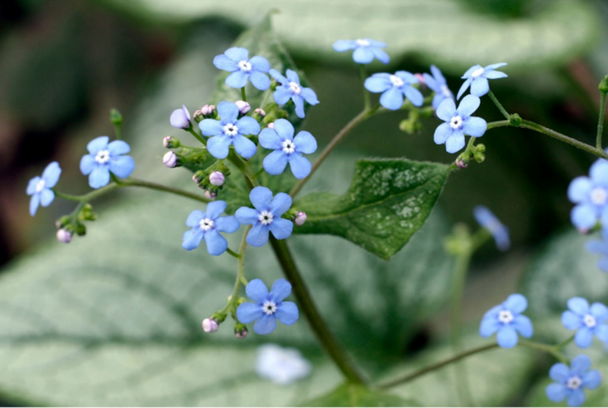
Brunnera macrophylla ‘Jack Frost’
Also known as Siberian bugloss, this shade-loving perennial is valued for its attractive foliage. The heart-shaped leaves are silver and green with intricate veining. In the spring clusters of small, light blue flowers rise above the foliage on slender stems. This plant is easy to grow and thrives in moist, well-drained soil in partial to full shade.
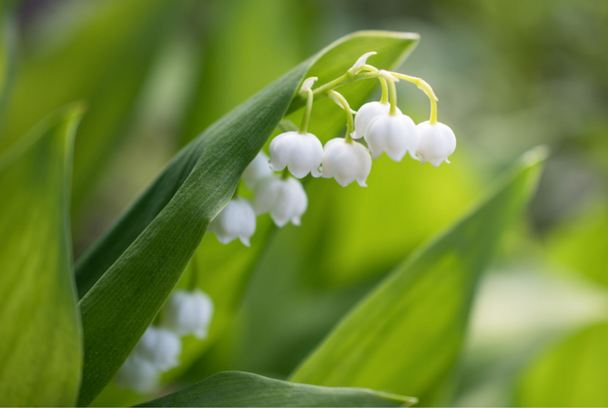
Convalaria majalis
Commonly known as Lily of the Valley, this perennial bears small, white, bell-shaped flowers that hang from arched stems. Its glossy green leaves add a lush appearance. It blooms in spring and has a sweet fragrance that attracts bees and other pollinators. It is perfect for partial or full shade.
Thrive or survive
“Right Plant, Right Place” is a gardening concept which emphasizes putting plants in locations that provide its ideal growing conditions. If you provide the optimal amount of light, moisture, and soil conditions, it is more likely to thrive. This can make the difference between plants thriving, just surviving or dying. Plants that thrive are healthier, require less maintenance and are more resistant to pests and diseases.
A plant that requires full sun needs at least 6 hours of direct sunlight per day. A plant that prefers shade needs to avoid the midday sun. Some plants refer to being suitable for full sun to partial shade, but they may prefer one over another. Many plants, like crocosmia for example, will grow in partial shade but will bear fewer flowers or maybe even none at all.
Choosing the right plants for your unique location will cost you less in the long run. You will not need to replace plants that fail to grow or become disheartened and give up. It will also ensure your garden is lush and beautiful no matter how much sun or shade there is.
By our resident horticultural expert





